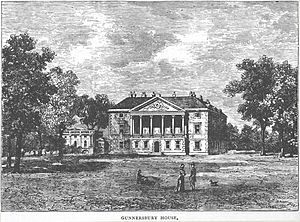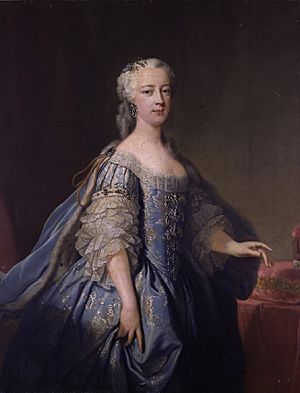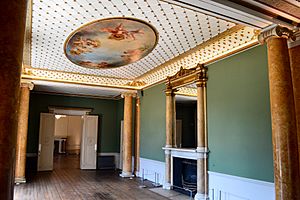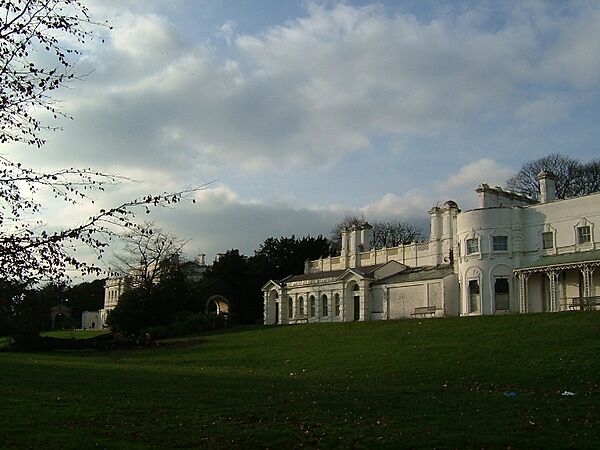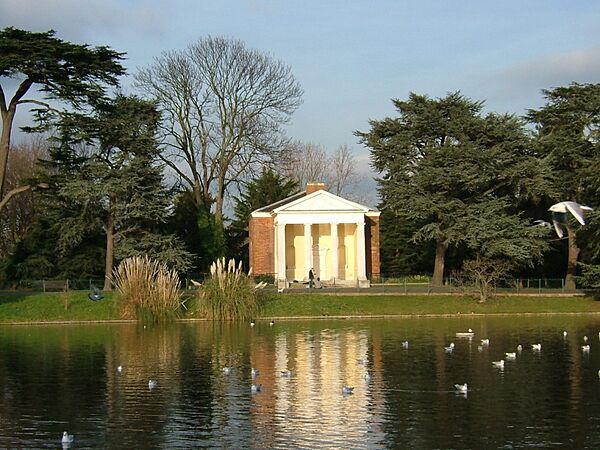Gunnersbury Park facts for kids
Quick facts for kids Gunnersbury Park |
|
|---|---|
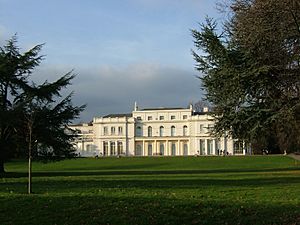 The Large Mansion at Gunnersbury |
|
| Ceremonial county | Greater London |
| Region | |
| Country | England |
| Sovereign state | United Kingdom |
| Post town | LONDON |
| Postcode district | W |
| Dialling code | 020 |
| Police | Metropolitan |
| Fire | London |
| Ambulance | London |
| EU Parliament | London |
Gunnersbury Park is a large park located in West London, England. It sits between the areas of Acton, Brentford, Chiswick, and Ealing. This beautiful park was once owned by the wealthy Rothschild family. It was bought for the public and opened on May 21, 1926, by Neville Chamberlain, who was a government minister at the time.
Today, Gunnersbury Park is looked after by the local councils of Hounslow and Ealing. A big project to make the park look new again finished in 2018. This project was helped by money from the Heritage Lottery Fund. The park and its gardens are very important, so they are listed as a Grade II historic site.
In the late 1800s, when Leopold de Rothschild owned the park, he made the gardens very special. He created a new type of "woodland garden" using many new plants from Asia. Other cool parts of the park included a formal "Italian Garden," colorful flower beds, a glass orangery (a greenhouse for orange trees), a rock garden, and one of the first "Japanese gardens in England." These features are still there today, even if they aren't as perfectly kept as they were a hundred years ago.
Contents
History of Gunnersbury Park
How Gunnersbury Got Its Name
The name Gunnersbury comes from a woman named Gunylda. She was the niece of King Canute and lived here until she was sent away from England in 1044. Later, in the 1400s, the Frowyk family lived on this land. Sir Thomas Frowyk, a very important judge, was born here in 1460.
Early Houses and Owners
In the mid-1600s, a lawyer and politician named Sir John Maynard bought Gunnersbury. He lived during the time of Oliver Cromwell. Around 1663, Sir John built a grand house called Gunnersbury House. It was designed by John Webb, who was a student of the famous architect Inigo Jones. The house looked like a Palladian mansion, similar to old Roman buildings. A map from 1777 shows the house in the park's north-east corner, facing a lake shaped like a horseshoe.
In 1739, a rich merchant and politician named Henry Furnese bought the house. After he passed away in 1756, it was sold to Princess Amelia, who was the daughter of King George II.
Daniel Defoe, a famous writer, visited Gunnersbury in 1742. He wrote that the house was on a hill, with great views of the countryside, the River Thames, and even London on a clear day.
Princess Amelia's Time
In 1760, Princess Amelia bought Gunnersbury House and its land. She was a favorite daughter of King George II. Princess Amelia was known as "that odd and hearty lady" and made Gunnersbury famous for her parties.
The previous owner, Henry Furnese, had already hired William Kent to design the gardens in the popular 18th-century landscape style. Princess Amelia continued this work. She even built a special bathhouse in the park.
Changes in the 1800s
After Princess Amelia died in 1786, the estate had several different owners. In 1801, one owner decided to pull down the old mansion. He then sold the land in many small pieces. However, only two people ended up buying all the pieces.
One buyer, Alexander Copland, bought most of the land (about 76 acres). He was a builder and built a new, much larger house. This house and its grounds became known as "Gunnersbury Park."
Another house, called the "Small Mansion," was built nearby between 1806 and 1809. This house and its land were known as "Gunnersbury House." Both new houses were built in a great spot overlooking the horseshoe-shaped lake.
The Rothschild Family Takes Over
In 1835, a very rich banker named Nathan Mayer Rothschild bought the Large Mansion and Gunnersbury Park. Later, in 1889, the Rothschild family also bought the Small Mansion and its land. This finally brought the original estate back together under one owner.
The Rothschilds made Gunnersbury even bigger. They added more land to the west and north. An old clay pit in the south-west was turned into a beautiful lake called Potomac. They also changed an old tile-kiln into a boathouse that looked like a gothic folly (a decorative building). In 1836, a new orangery was built for growing citrus trees.
Gunnersbury Park in the 1900s
In 1925, after Leopold de Rothschild passed away, his wife and son sold the 200-acre Gunnersbury estate. It was bought by the nearby Ealing and Acton councils for £130,000. Even though the land was outside their own areas, they wanted to protect it. Ealing didn't want more houses built there, and Acton agreed to help buy it as a park.
After the First World War, there was a big need for land to build houses. Also, a new main road, the Great West Road, was being built south of the park, bringing new factories and businesses. Leopold's son, Lionel, had bought another large estate in 1919 and was developing its gardens. Selling Gunnersbury helped him with that.
Some people in Ealing were not happy about the cost of buying the park. The council of Brentford and Chiswick also thought Ealing already had enough parks. They wanted most of the land to be used for housing. However, the idea of having a grand public park won out. The Rothschilds sold Gunnersbury on the condition that it would only be used for fun and recreation. Only a few houses could be built along Popes Lane and Lionel Road to help pay back the loan.
When Neville Chamberlain opened the park on March 21, 1926, he was very happy that people now owned "so magnificent and historical a park." He said it was a shame that earlier generations hadn't created more open spaces in towns.
In 1929, the large mansion was turned into the Gunnersbury Park Museum. It showed local history, old clothes, and art. A cemetery, called Gunnersbury Cemetery, was also created nearby that same year.
In 1965, the park became part of the London Borough of Hounslow. A special committee with Ealing was set up in 1967 to manage it together.
Gunnersbury Park Today
A huge restoration project, costing £50 million, finished in June 2018. The large mansion reopened after four years of work. This project was supported by the Heritage Lottery Fund, Ealing Council, Hounslow Council, and English Heritage. A new outdoor sports area opened to the public in 2020.
In July 2024, something new happened: two Kunekune pigs were allowed to graze in the park! They help keep the shrubs tidy and the grass short. This was the first time in the park's history that pigs had grazed there.
Gallery


